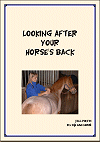Equine Massage
Equine Massage is the therapeutic application of professional sports massage techniques applied to the horse. These hands on techniques accomplish increased performance levels and endurance as well as helping to prevent injury. They improve the rate of recovery from injury by increasing circulation and reducing muscular tension and stress, the primary causes of muscle injury. It is also of great value for mental relaxation and the prevention of muscle atrophy. Small muscle injuries can take up to 90 days to become apparent (by a change in attitude, decreased performance or lameness) by which time they may have caused more serious injury.
More about Equine Massage
Prompt attention to those "minor" muscle injuries not only enhances a horse's performance but may prevent future problems. Muscle tightening is transmitted from one muscle group to another so, for example, shoulder tension may be transmitted to the muscles of the forearm, resulting in extra stress being placed on the tendons.
How does Massage benefit your horse?
More than 60% of the horse's body weight is muscle and muscular problems can be a frustrating source of a variety of motion problems and training set-backs.
Most of us are quick to accuse a horse of being un-genuine, uncooperative-operative or even dangerous when they may be in pain. How many horses never reach their true potential? In the performance horse, massage enables the horse to compete to its full potential by increasing circulation, enhancing muscle tone, relaxing muscle spasm and increasing the range of movement. Massage also helps to prevent injury. In the non-competition horse, massage can benefit the well-being of the animal, release tension and aid mental relaxation.
How to massage your horse
Jill Firth is a McTimoney Animal Practitioner and specialises in horse mobility and performance problems. She has written an eBook which shows you how to look after your horse's back and improve mobility through massage and stretching exercises.
Her website explains more about Equine Massage and you can download her eBook "Looking After Your Horse's Back" so that you can learn some of the techniques yourself.
Who are the ESMA?
The Equine Sports Massage Association was formed to ensure that the client receives services from a fully trained and qualified therapist. It will also endeavour to maintain a high standard of practice and code of conduct by all its members. All members of ESMA are experienced horse people and in addition are qualified in human massage. They have all received training from the leading physiotherapist, Mary Bromiley, resulting in passing the ITEC Diploma in Equine Sports Massage.
The Honorary President: CLIVE J. HAMBLIN MRCVS
Clive Hamblin MRCVS qualified in 1976, he has spent most of his career working with the equine. His particular interests are equine athletic injury and equine orthopaedics. He was 15 years an amateur jockey, during which time he rode winners in both Point-to-Points and under rules. He now owns his own business. On the subject of Equine Sports Massage Clive Hamblin MRCVS says "there is a serious role for Equine Sports Therapists working in conjunction with conventional Veterinarian therapies under the guidance of the attending veterinarian. Massage can have a positive role in the prevention of athletic injury in the normal training process."
